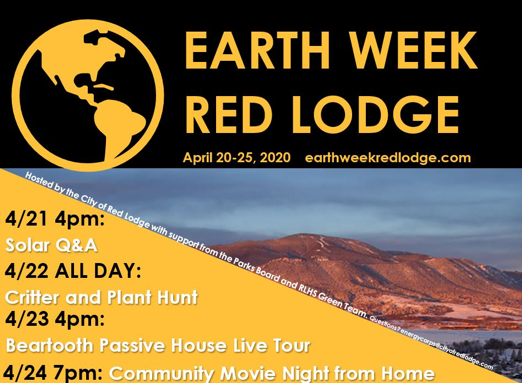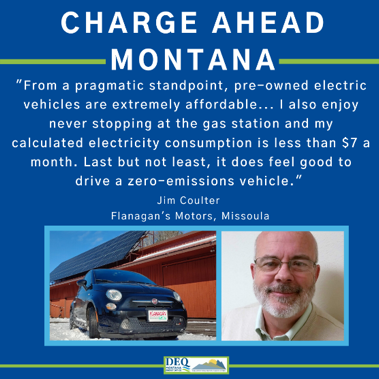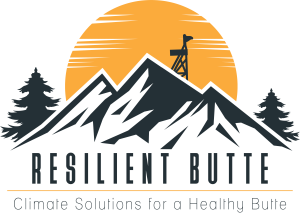Climate science traces its origins back to the discovery of the earth’s “greenhouse effect” by French mathematician and physicist Jean Baptiste Joseph Fourier in 1824. Fourier had made some fundamental calculations of what the temperature of a body in space should be given its distance from the sun and determined…
Climate science traces its origins back to the discovery of the earth’s “greenhouse effect” by French mathematician and physicist Jean Baptiste Joseph Fourier in 1824. Fourier had made some fundamental calculations of what the temperature of a body in space should be given its distance from the sun and determined…
Climate science traces its origins back to the discovery of the earth’s “greenhouse effect” by French mathematician and physicist Jean Baptiste Joseph Fourier in 1824. Fourier had made some fundamental calculations of what the temperature of a body in space should be given its distance from the sun and determined…
The Resilient Butte Steering Committee is seeking a project planner to work with the committee in developing a climate solutions plan for Butte-Silver Bow. The committee has issued a Request for Proposals for a planning consultant, available at this…
The Resilient Butte Partnership is seeking an individual, business, or organization to assist a project steering committee in developing a community climate solutions plan that will prepare the community for climate-related disruptions, safeguard public health, reduce emissions, and pursue opportunities in the emerging green energy economy.
The Partnership requests qualified consultants (independent contractors) or potential job applicants to respond to a Request for Qualification, available at this link. Interested parties should submit a Statement of Qualifications (SOQ), including a resume and cover letter, by November 8, 2022.
Responses to this RFQ will determine whether the partners choose to issue a formal Request for Proposal (RFP) for an independent contractor or, instead, to fill a staff position housed at the National Center for Appropriate Technology in Butte. The duties, deliverables, and scope of work will differ depending on which option is selected. The purpose of this RFQ is to provide an opportunity for both independent consultants and job seekers to apply and for the partnership to determine the best fit for this role based on qualifications.
The Resilient Butte Partnership is a project of the National Center for Appropriate Technology (NCAT), Montana Technological University and the consolidated city-county government of Butte-Silver Bow, Montana.
By: Rylie Yaeger, VISTA Volunteer
When I lived in Beijing, people would always ask me how the pollution was. I told them two things: the Communist Party planted trees to stop sandstorms from entering the capital. Second, they also moved factories away from the city, yet didn’t shut them down. Despite all this, the Chinese capital still experiences terrible air quality for periods of the year. This past summer I moved home to Minnesota and was amazed to watch everyone taking pictures of the smoky haze drifting east from California, Washington, and Oregon and south from Canada. While this was new for them, I was reminded of Beijing. A picturesque lake, glazed over with a harsh bite of reality: the wildfire smoke had finally reached the boundary waters of Northern Minnesota. Little did I know that I would soon move to the largest EPA superfund site in the United States, Butte, Montana where they have been dealing with these environmental issues for decades.
A hundred years ago, at the height of a copper mining boom, Butte was the largest city between Chicago and the West. After most of the mines shut down, Butte’s population plummeted to only a fraction. Now, the community is growing again after decades of environmental restoration.
Butte’s future will be shaped by opportunities and challenges related to climate change. Butte is seen by private industry as a good location for clean energy development with recent proposals to develop solar, green hydrogen, and energy storage systems. However, the community faces climate challenges that threaten to undo much of the environmental work of recent years. Community leaders are eager to understand the challenges and achieve the opportunities by developing a climate adaptation and green energy plan. Thus, our project was born—Resilient Butte.
Butte-Silver Bow County, Montana Technological University, and the National Center for Appropriate Technology (NCAT) are partnering to create a Butte Sustainability and Resilience Plan. Unlike us Minnesotans, Montana has been battling drought and wildfire risk for years—risks that are only getting worse.
One priority is to protect the Basin Creek watershed, the main source of Butte’s drinking water. Vast areas of beetle-killed lodgepole pine in the watershed are at risk of burning in a wildfire, which could fill the reservoir with sediments and plug water treatment filters. Even further, many Butte residents live in old buildings without proper insulation and weatherization, which pose health risks from rising temperatures and wildfire smoke. Those are just a couple issues we want to tackle with this new plan. But our plan isn’t just about the negatives.
Butte has a rich history. It is well-positioned and has the potential to become a fantastic renewable energy hub. Butte industrial products, including silicon gas and copper, are essential for solar energy. In recent years, Butte has been approached by large-array solar and green hydrogen energy developers, but county officials haven’t yet developed land-use plans to accommodate these new uses. Meanwhile, the county is eyeing infrastructure investments through the U.S. Department of Energy to develop clean energy projects on former mine lands. The Resilient Butte project will provide an economic development guide for the city-county.
With our first steps towards Resilient Butte, we’d like to invite the residents in Butte to participate in a survey that can be found at: ResilientButte.org. We would like to also invite you to connect with Resilient Butte on Facebook and Instagram and at our website Resilient Butte. Get involved and help shape Butte’s climate adaptation and green energy plan!
By: Andrew Mades, VISTA Volunteer
The National Center for Appropriate Technology is partnering with Montana Campus Compact (MTCC) to create a MTCC VISTA “Resilience Cohort.” This cohort will consist of AmeriCorps VISTA members serving in rural communities around Montana, building capacity for anti-poverty and education initiatives through the lens of local resilience. NCAT will continue to host a VISTA in support of the Resilient Butte initiative, plus a second VISTA member who will coordinate the various programs and grow the Resilience Cohort project.
Resilience in this instance refers to the ability of a community at the city, county, tribal, or regional level, to withstand shocks and plan for the future, and adapt to and mitigate climate change. The climate crisis is most acutely felt at the local level, and among disadvantaged groups. Using the Montana Department of Commerce’s Montana Resilience Framework as a guide, Resilience Cohort members will meet communities where they are, holding community conversations around climate disruption, local challenges, and local solutions.
MTCC is currently recruiting for five positions to begin at the start of the next service term, August 15, 2022. Each position is based in a small, rural Montana community. Cities include Havre on the Canadian border, Livingston just north of Yellowstone National Park, Red Lodge located south of Billings Polson on Flathead Lake and the Flathead Indian Reservation near Glacier National Park, and Poplar, on the Fort Peck Indian Reservation in the northeast of the state.
Havre: Opportunity Link seeks systemic solutions to reduce poverty and help the communities of Northcentral Montana achieve and sustain independence, prosperity and a better way of life. As an AmeriCorps member you will collaborate with Aaniiih Nakoda College and Stone Child College, staff and community members on the Rocky Boy and Fort Belknap Indian Reservations to research and develop materials to offer a series of trainings designed to increase the capacity of current and potential local food growers to create an economically successful business through their agricultural activities. Apply Today!
Livingston: The Park County Environmental Council works with the community to safeguard the land, water, wildlife, and people of Yellowstone’s Northern gateway through grassroots organizing and community advocacy. As an AmeriCorps member you will perform a needs assessment of the community and identify solutions for the most pressing threats posed by a changing climate (wildfires, droughts, agricultural impact, tourism impact, community mental health, etc.). Based on this assessment, you will develop a Park County Community Resilience Plan based upon the model of the Montana Resilience Framework. Apply Today!
Polson: Since 1958, the mission of Flathead Lakers has been to protect clean water, healthy ecosystems, and a lasting quality of life in the Flathead watershed. As an AmeriCorps member, you will assess the greatest needs in the region’s low-income communities related to climate resilience, such as the increased risk of wildfire and flooding posed by climate change. Based on this assessment, you will develop strategic outreach and communication plans to promote landscape and community resilience in the Flathead Watershed. Apply Today!
Poplar: The Office of Environmental Protection for the Fort Peck Tribes works to provide a better world for tomorrow by conserving the natural resources of the Fort Peck Reservation. As an AmeriCorps member, you will help to establish a climate resilience plan for the Tribes by community assessment activities and researching preparedness strategies. The resilience plan will enable communities to better respond to the impacts of climate change and to be better prepared for environmental disasters and environmental system shocks. Apply Today!
Red Lodge: The Planning and Zoning Division of the City of Red Lodge administers the city’s growth management program. As an AmeriCorps member you will serve at City Hall under the supervision of the city’s Planning Director in close partnership with the Red Lodge Area Community Foundation to perform an assessment of the Mountain Springs Villa low-income housing area. You will evaluate options to improve green infrastructure and engage in fundraising activities to implement identified infrastructure improvements. Apply Today!
For more information about AmeriCorps, the VISTA program, MTCC, or any of the service positions listed above please visit https://mtcompact.org/. Other service positions, in addition to those listed above, can be found here.
For more information about the Resilience Cohort, please write to amades@ncat.org.
As we celebrate Earth Day 2020, the Earth looks and feels quite different than it normally does. This year marks the 50th celebration of Earth Day and the COVID-19 pandemic, has drastically impacted our physical, social, and economic worlds. Even so, people are banding together and finding a “new normal,” — one that demonstrates resilience. We can still pursue our projects and initiatives, though; we just need to do it differently. And, at least for now, our communication must be virtual.
Energy Corps AmeriCorps members have quickly adapted their service, exemplifying this resilience. Earth Day is an important event, one than typically involves a wide range of events and activities planned and carried out by members. In the face of physical distancing and shelter-in-place orders, members have refocused their efforts to embrace creative virtual opportunities.
For example, Alli Kane, Energy and Climate Educator in Missoula, has taken an artistic approach to increasing awareness and getting people excited about Earth Day. Earth Day Art 4 All is a community art project led by Climate Smart Missoula and Families for a Livable Climate, and anyone with a creative itch can join. Alli encourages people to create Earth Day-related art to display outside their home, such as banners, window art, or sidewalk chalk drawings. Participants can send a photo of their art to alli@climatesmartmissoula.org and those submissions will be used to produce a virtual art show. The broad theme of this art project is “Healthy People, Healthy Community, Healthy Plant,” but get creative and show your love for our planet in any way you choose. Visit their website for more information.
Robin Adams, Sustainability Coordinator for the City of Red Lodge, is dedicating an entire week to celebrate Earth Day by hosting daily virtual activities and tours. The week’s activities include a Solar Q&A with experts Henry Dykema of Sundance Solar Systems and Andrew Valainis of the Montana Renewable Energy Association; a Critter and Plant Hunt using iNaturalist social networking site; a Beartooth Passive Home Live Tour; and a Community Movie Night. Visit their website to learn how you can get involved.

The event schedule for Earth Week in Red Lodge.
Maia Madrid, Electric Vehicle Outreach Coordinator for the Department of Environmental Quality, has created a visual interview graphic series that displays feedback from Electric Vehicle (EV) owners. A part of Maia’s service is to develop this project and provide insight into driving and buying EVs. There are only four car dealerships in Montana that sell EVs and she is working to expand awareness of this sustainable transportation technology. The visual interview project will be launched in honor of Earth Day, and you can check it out on their website.

An excerpt from the interview graphic series.
Check out these and other virtual events and get involved!
We want to thank Energy Corps and their host-site organizations for so eloquently transitioning regular programming to an online outlet. The motivation, dedication, and creativity displayed by this group is inspirational during these uncertain times. Other organizations are providing opportunities to be involved in the festivities, like the National Park Foundation providing virtual park tours, as well as Earth Day Live events found on the official Earth Day website. What better way to recognize that we, as a collective, can be resilient to hardship and therefore able to collectively revive the health of our planet and its people.
